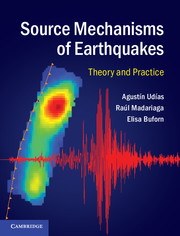Book contents
- Frontmatter
- Contents
- Preface
- Chapter 1 Earthquakes and fault motion
- Chapter 2 Processing and analysis of recorded seismic signals
- Chapter 3 Mathematical representation of the source
- Chapter 4 Point source models
- Chapter 5 The seismic moment tensor
- Chapter 6 Determination of point source mechanisms
- Chapter 7 Kinematics of extended sources
- Chapter 8 Determination of source dimensions
- Chapter 9 Simple dynamic models
- Chapter 10 Dynamics of fracture. Homogeneous models
- Chapter 11 Fracture dynamics. Heterogeneous models
- Chapter 12 Modeling earthquakes using fracture dynamics
- References
- Index
Chapter 10 - Dynamics of fracture. Homogeneous models
Published online by Cambridge University Press: 05 June 2014
- Frontmatter
- Contents
- Preface
- Chapter 1 Earthquakes and fault motion
- Chapter 2 Processing and analysis of recorded seismic signals
- Chapter 3 Mathematical representation of the source
- Chapter 4 Point source models
- Chapter 5 The seismic moment tensor
- Chapter 6 Determination of point source mechanisms
- Chapter 7 Kinematics of extended sources
- Chapter 8 Determination of source dimensions
- Chapter 9 Simple dynamic models
- Chapter 10 Dynamics of fracture. Homogeneous models
- Chapter 11 Fracture dynamics. Heterogeneous models
- Chapter 12 Modeling earthquakes using fracture dynamics
- References
- Index
Summary
Griffith's fracture model
In the previous chapter we studied a simple circular earthquake model proposed by Brune (1970). In that model the amount of radiated energy was about 45% of the strain energy released by the elastic body, so where does the rest of the energy go? It goes into the creation of the fracture surface or fault. This energy is released near the edge or tip of the fault, that is, the place where the material passes from being unbroken to being broken (Kostrov and Das, 1988, pp. 53–62). In the case of a homogeneous, continuous, perfectly elastic material, the material ahead of the fracture front is continuous and elastic and behind the front it is discontinuous (broken). In a tensional fracture (Mode I, see section 9.3), when the two sides of the fracture become separated by a crack-opening displacement Δu, the stress behind the front is zero and the stress drop is total. This situation is usually the one considered in engineering applications. Alan Griffith in 1921 introduced the first elements of brittle fracture in his work on the fracture of metals. At that time it was generally accepted that the strength of a material was about one tenth of the value of Young's modulus. However, in practice, from laboratory experiments it was known that the critical strength at which material fracture occurred was about a thousand times lower. Griffith made the hypothesis that the presence of small cracks lowered the strength of the material, causing it to fracture long before it reached its theoretical breaking strength. He assumed that the surface energy dissipated by the forming of a new crack surface is equal to the resistance to crack growth. To create a new unit area of fracture a certain amount of energy per unit surface, γ, was necessary, which he called the effective specific surface energy. He assumed that γ was a material constant. According to Griffith, for the crack to grow by a new surface element δ S, it was necessary to provide it with an amount of energy equal to 2γδS (the factor 2 is for the two sides of the fracture).
- Type
- Chapter
- Information
- Source Mechanisms of EarthquakesTheory and Practice, pp. 205 - 231Publisher: Cambridge University PressPrint publication year: 2014



